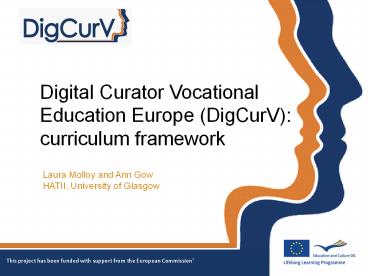Digital Curator Vocational Education Europe (DigCurV): curriculum framework - PowerPoint PPT Presentation
1 / 15
Title:
Digital Curator Vocational Education Europe (DigCurV): curriculum framework
Description:
Digital Curator Vocational Education Europe (DigCurV): curriculum framework Laura Molloy and Ann Gow HATII, University of Glasgow This project has been funded with ... – PowerPoint PPT presentation
Number of Views:143
Avg rating:3.0/5.0
Title: Digital Curator Vocational Education Europe (DigCurV): curriculum framework
1
Digital Curator Vocational Education Europe
(DigCurV) curriculum framework
- Laura Molloy and Ann Gow
- HATII, University of Glasgow
This project has been funded with support from
the European Commission'
2
Some basic facts
- Network funded under the EC Leonardo da Vinci
Lifelong Learning programme - Aims support and extend vocational training for
digital curators in libraries, archives and
museums - 1 January 2011 30 June 2013 (30 months)
http//www.digcur-education.org/
3
Founding partners
- Initial European partners
- Fondazione Rinascimento Digitale (FRD)
- Georg-August-Universität Göttingen Stiftung
Öffentlichen Recht, Goettingen State and
University Library (UGOE) - Humanities Advanced Technology Institute (HATII)
at University of Glasgow - MDR Partners (Consulting) Ltd (MDR)
- Trinity College Dublin (TFTCD)
- Vilniaus Universiteto Biblioteka (VUL)
- Associates and partners from other countries
- Faculty of Information at the University of
Toronto - University of North Carolina, Chapel Hill
- nestor
- Digital Preservation Coalition
- Institute of Museum and Library Services
http//www.digcur-education.org/
4
Wider network
- Wider network
http//www.digcur-education.org/
5
Main activities
- Identify and analyse existing training
opportunities and methodologies - Training registry
- Survey training needs
- Identify key skills and competences
- Focus groups, job adverts analysis
- Create a curriculum framework
- Test with communities
- Promote the results for use within and across
countries
http//www.digcur-education.org/
6
Curriculum Framework
http//www.digcur-education.org/
7
DPOE Three audiences for training
From Training Needs Assessment Survey (2010).
Digital Preservation Outreach and Education
(DPOE). Washington DC, US Library of Congress.
dpoe_at_loc.gov
http//www.digcur-education.org/
8
Draft curriculum framework
- Portfolio of three lenses to reflect career
progression Practitioner, Manager and
Executive - Indicate digital curation skills and competences,
and pathways of skills progression - Framework i.e. will NOT specify a particular
training curriculum
http//www.digcur-education.org/
9
Draft curriculum framework
- Framework i.e. will NOT specify a particular
training curriculum. - Simon Grant, JISC CETIS
- a place to visit should not be confused with
an itinerary for that place. Any real place has
an unlimited number of possible itineraries for
it. An itinerary for a city may include a museum
an itinerary for a museum may include a painting
there may sometimes even be guides to a painting
that direct the viewer to particular features of
that painting. The guide to the painting is not
the painting the guide to the museum is not the
museum the guide to the city is not the city. - Simon Grant, The logic of tourism as an analogy
for competence. Published online 1 May, 2012 at
http//blogs.cetis.ac.uk/asimong/2012/05/01/touris
m-analogy/
http//www.digcur-education.org/
10
Practitioner lens
http//www.digcur-education.org/
11
Manager lens
http//www.digcur-education.org/
12
Executive lens
http//www.digcur-education.org/
13
How to use the Curriculum Framework for Digital
Curation
Background DigCurV has undertaken multi-national
research to understand the skills currently used
by those working in digital curation in the
cultural heritage sector, as well as the skills
sought by employers in this sector.
Using the framework The framework provides three
lenses - one each for practitioners, managers and
executives. Each lens can be used in the
following ways
To build or develop training The framework aims
to be useful to those building new training
courses. Depending on the users aims, the
framework can assist in providing a structure for
a generic training programme for the role of
digital curator, or it can suggest which
subjects should be covered in shorter, more
specialised courses addressing one particular
area of professional digital curation practice.
The framework may also supply a common language
to allow those building and developing training
to meaningfully describe the value of their
training offerings.
Audiences for training Practitioners need to be
able to perform a wide variety of technical and
people-oriented tasks. They must also understand
many diverse issues relating to both their area
of cultural heritage and to digital curation.
Managers need understanding of these areas to
successfully ensure projects are on track and to
advise their teams. Executives need a strategic
view of digital curation to understand the
emerging challenges in digital curation for the
cultural heritage sector, and to make appropriate
funding decisions to meet these challenges. The
DigCurV curriculum framework provides a version
or lens for each of these three audiences.
To compare existing courses The framework
provides a benchmark against which to compare
existing training and also a way to map various
training offerings against each other. The
professional who is considering undertaking
training may wish to compare available training
programmes to help identify which is most
appropriate for their needs. The framework can
also be used by staff training providers to
compare existing courses and assess suitability
for their own institutions requirements.
To plan professional development The framework
suggests the broad range of skills and knowledge
needed by professionals of various levels to
successfully deliver digital curation in the
cultural heritage sector. Individuals either
intending to enter or already working in digital
curation in the cultural heritage sector may find
it useful to map their own strengths against the
framework as well as use the framework to
identify and describe areas in which they would
find further training useful.
Further information about the DigCurV project is
available at http//www.digcur-education.org/
14
Use is key
- Three main intended uses of each lens
- To build or develop training
- To compare existing courses
- To plan professional development
http//www.digcur-education.org/
15
- Access the curriculum framework
- www.digcur-education.org/eng/Resources
- More information and join the network at
- www.digcur-education.org































